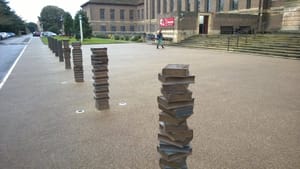Writing here about the digitization initiatives in the “Google 5” libraries a while ago I referred to aura:
Walter Benjamin famously asserted that “that which withers in the age of mechanical reproduction is the aura of the work of art”. In his terms, the aura is that which is original or authentic about a work. Aura depends on the position of a work within a tradition and its uniqueness. Reproduction diminishes each, the argument goes. [Lorcan Dempsey’s weblog]
I was reminded of this while listening to Ken Hamma’s interesting presentation at the CNI Spring Taskforce meeting earlier this week.
Instead of asserting intellectual property rights in images of public domain works as nearly every art museum does now, it is argued here that publicly and pro-actively placing these images in the public domain and clearly removing all questions about their availability for use and reuse would likely cause no harm to the financial position or trustworthy reputation of any collecting institution and would demonstrably contribute to the public good. As those images have become digital assets and as the preferred delivery venue has become increasingly an electronic network, the ante has been raised to do so. The manner in which this might be done may require consultation with legal counsel. The fact of doing it, however, is not a legal decision but a business decision that can be evaluated by non-profits in measuring success against the mission. Project Briefing-Spring 2005 Task Force Meeting]
Ken referred to Benjamin’s essay in his talk. During discussion it was argued that the distribution of images of works of art – on posters, etc – translates into increased traffic to see the real artifacts, the works of art in situ in galleries or museums.
I wondered if one could think of this as the allure of aura. Exposure to the ‘mechanically reproduced’ copies, drained of aura, creates a demand to experience the work of art itself.
I also wondered whether this points to an important difference between museum and library collections, and hence in our experience of their digitization. Much of what is in libraries is already a ‘mechanical reproduction’; it is one of many copies in a publishing process. In digitizing it, we are translating it into another medium. We experience it differently: but we are not losing that aura of uniquencess. Of course, the exception is where an individual volume has some particular characteristics which make it special, because it is rare, or is annotated, or for some other reason.
Much of what is in a museum or gallery is unique. We do indeed diminish the aura in reproduction.



